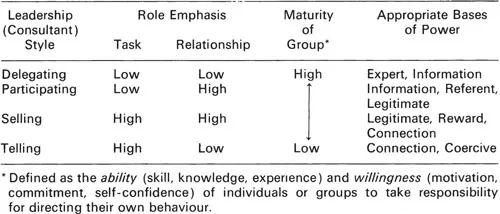![]()
Consulting with Education Systems is about the Facilitation of Coordinated Effort
Bill Mulford
Canberra College of Advanced Education
Introduction
Writing in confessional vein, Reddin (1977; 36) explains that as a change agent he has been attached to different organizations as, ‘servant, master, captive behavioural scientist, visiting professor, tame seal and resident magician’. He adds, ‘I sometimes have to remind clients that I have not walked on water recently. Sometimes I have to remind myself. While Reddin’s self analysis raises the question of the different roles external consultants can have in working with education systems, they also point to some of the important issues that need to be resolved by consultants in their relationship with those systems. These issues include the over-dependence of clients on consultants and the over-confidence of consultants in their own abilities or importance.
It is my intention in this chapter to mention some of the different roles consultants can take when working with systems and to illustrate the particular importance, but difficulty, in the facilitation of coordinated effort role in their contact with education systems. The focus will be on the area of school evaluation. I propose to raise and to examine in more detail at least five of the factors that need to be considered to ensure an effective carrying out of this role.
Consultant Roles
Consultants will take one or more roles in their attachment to education systems. Sometimes the consultant may take a very active role in initiating or carrying out an intervention. At other times within the same or a different situation, the consultant role may be passive or indirect, but still important to the success of the intervention. In facilitating an intervention, the consultant may include among his or her roles that of referrer to other courses, linker to a trainer to be brought in, manager of a sequence of activities conducted by others, process observer, trainer, and analyzer of data about the system.
It seems obvious that it is critical for consultants to maintain clarity between role switches as they work with a client. Some would go further and suggest that because of the role expectations the client builds up for the consultant, a situation could arise when it would be better to bring in a different consultant to help the client with particular needs, even when the original consultant has the requisite skills and knowledge.
Later in this chapter it will be argued that one particular consultant role makes the most sense when working with education systems, and that to step outside this role would be to negate the role itself. But for now let us seek clarification of the possible differences in the roles consultants may hold when working with education systems.
Bennis (1973) identified three roles for a change agent: training, consultancy, and applied research. While not focusing solely on the consulting role, he emphasizes the roles of educator and fact-finder. Lawrence and Lorsch (1969) propose a three-fold role for an OD specialist: diagnostician (to identify organization problems and analyze their causes), educator (to train organization members in the use of concepts to conduct diagnoses and to plan action), and consultant (to provide action proposals for consideration by an organization). Havelock (1973) in seeing consultancy in a problem-solving context, has a similar classification, although he uses the terms Catalyst, Process Helper, and Solution Giver. Both he and Menzel (1975), however, add a fourth role of Linker, effecting the linking of the best resources with the correctly identified needs. Eraut (1977), in analyzing the relationships between teachers and significant others outside the school but within the education profession, has identified a preliminary typology consisting of eleven consultant roles. The eleven roles are:
The Expert
The Resource Provider
The Promoter
The Career Agent (a role, rarely made explicit, of assisting promotional opportunities)
The Link Agent (to resources of information and advice, or to other teachers and schools)
The Inspector/Evaluator
The Legitimator
The Ideas Man (providing ideas for consideration rather than for adoption, without claiming any special authority)
The Process Helper
The Counsellor
The Change Agent
Jung (1977) goes further and lists the following nineteen different major roles a consultant can take:
| Expert | Counsellor |
| Instructor | Adviser |
| Trainer | Observer |
| Retriever | Data Collector |
| Referrer | Analyzer |
| Linker | Diagnostician |
| Demonstrator | Designer |
| Model | Manager |
| Advocate | Evaluator |
| Confronter | |
Some writers have sought to group these burgeoning lists of consultant roles. Margulies and Raia (1972) divide what the consultant does into ‘task oriented’ and ‘process oriented’. In considering the consultant in schools, Schmuck (1973) differentiates among three approaches: Consultative Assistance — which brings technical expertise to a problem situation, but does not change the skill levels of organizational members, nor affect the inter-personal relations among them; Content Consultation – which aims at educating members in a substantive area and seeks to bring about individual changes in understanding, attitude or skill, but does not focus on the organization; and Process Consultation – which focuses on such organizational phenomena as communication patterns, planning, decision-making and interpersonal relationships.
Lippitt and Lippitt (1978) have developed a descriptive model that presents the consultant’s role along a directive and non-directive continuum. The nine points they identify along this continuum range from Advocate, Informational Expert, Trainer, Educator, Joint Problem Solver, Alternative Identifier and Linker, Fact Finder, Process Counsellor, through to Objective Observer/ Reflector (the least directive).
Clearly, an awareness of the different consultant roles or of the grouping of roles according to various criteria (such as task/process; directiveness/non-directiveness) might be of value for the individual consultant in understanding how he or she operates. However, of more practical significance would be the approaches that seek to link specific types of intervention to particular types of organizational problem or which describe the roles that consultants adopt during the intervention process. The OD Cube developed by Schmuck and Miles (1971) classifies OD interventions for organization development, namely, training, data feedback, confrontation, and process observation and feedback. Each of these interventions calls for unique behaviours on the part of the consultant. Schmuck and Miles (1971) include four other intervention modes that are especially applicable to large-scale OD efforts. These comprise a sequence of problem solving, plan making, establishment of a task force for continuing consultation, and some modification in the technostructural activities of the client system.
Blake and Mouton (1976) have produced a Diagnosis/Development Matrix which categorizes interventions into five types. These they name Acceptant, Catalytic, Confrontation, Prescriptive and the Application of Principles, Models and Theories of Human Change.
Hersey et al (1979) classify leadership style in relationship to the maturity of the group and to appropriate bases of power. Their four-fold classification could also be interpreted as an attempt to match situations with appropriate consultative behaviour. The links can be summarized as follows:
Cameron (1978), in building on the work of Jones’ (1973) Helping Relations Inventory and Cohen and Smith’s (1976) Intervention Cube, has developed a Consultant Intervention Analysis model consisting of the following intervention categories and sub-categories:
| Level | Group, Sub-Group, Individual |
| Type | Structured, Unstructured |
| Content | Task, Interpersonal |
| Intensity (of Confrontation) | Low, Medium, High |
| Function | Reflective, Supportive, Probing, Interpretive, Informative, Advocacy, Evaluative |
| Position (of Consultant) | Foreground, Background |
Cameron believes that the first subcategory in each of the six basic categories is a ‘safe’ behaviour from which a consultant might start. It is, however, not necessarily an appropriate behaviour as progress is made through the stages of process consultation outlined by Schein, (1969) i.e.:
Initial contact with the client organization
Defining the relationship, formal contact, and psychological contract
Selecting a setting and a method of work
Data gathering and diagnosis
Interventions
Reducing involvement
Termination
Unfortunately, Cameron does not elaborate on how his different categories would or should apply at the different stages of consultation. It may be that consultants tend to operate in a certain way no matter what the situation. In this respect Tichy’s work is of interest. (Tichy, 1974; Tichy, 1975; Tichy and Nisberg, 1976; Tichy, 1978). He has classified change agents by the way they themselves say they operate with clients. His resultant groupings were:
Outside Pressure
Organization Development (OD)
People Change
Analysis for the Top
Tichy discovered however that in the time between his original study in ...

